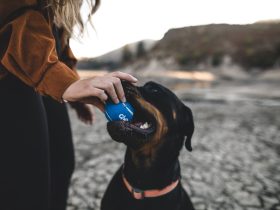How To Train Your Dog To Walk Nicely On A Leash
No matter what size or age of dog that you own, you will want them to walk nicely with you when they are on a leash. This means that wherever the two of you go walking, your dog will behave and not pull on the leash too much or become tangled up in it.
Being in crowded areas can be particularly challenging if your dog is new to his leash, so you need to use the right dog leash training skills to ensure that he does not jerk you around, and spin on the leash. The safety of your dog as well as yourself can depend on this.
 After your dog has been trained properly to walk with you on a leash, he will steadily walk by your side and his leash will not be tight. You need to be prepared to put some time and effort into this, and your patience may be tested at times. But this will pay off for you when your dog learns how to walk nicely on his leash.
After your dog has been trained properly to walk with you on a leash, he will steadily walk by your side and his leash will not be tight. You need to be prepared to put some time and effort into this, and your patience may be tested at times. But this will pay off for you when your dog learns how to walk nicely on his leash.
Be Prepared For Leash Training
It is important that you start out with the right equipment to get the best results. There are many types of dog leashes available, so choose one that will suit your dog. Choose a collar for your dog that is not too tight for him.
Have some treats to hand so that you can reward your dog when he does the right things. If you use a clicker then take that as well. Positive reinforcement training is recommended to encourage your dog to behave himself on the leash.
If you are leash training a puppy or a dog that has never been trained before, then go for shorter sessions to begin with. First you need to decide which side you want your dog to walk on. In competitions, dogs are usually taught to walk on the left side of their handler. If you have no intention of entering competitions, then you can choose either the left or right side. Whichever side you choose you need to stick with it, as your dog will learn not to move from one side to the other and trip you up in the process.
Things To Bear In Mind When Leash Training A Dog Or A Puppy
Your puppy or dog was not born with the knowledge that they should not pull ahead of you when they are on a leash or lag behind you. Leash training can be quite a challenge, as your dog will be very excited at the prospect of exploring the world outside, and they can move a lot faster than you can.
It is quite likely that they will not take to the leash straight away, as it imposes a restriction on their movements and freedom. Each dog will behave differently when they are out walking with their owner. Some will want to stop and look at everything that they come across. Others will want to sniff everything and urinate a lot, and others will just want to run about as much as they can.
 You need to be consistent with your training and not allow your dog room to try and take advantage of you. An example of this is when you are teaching your dog not to pull on the leash. If you are not consistent, then your dog will sometimes try and pull as he will think that sometimes this will work for him.
You need to be consistent with your training and not allow your dog room to try and take advantage of you. An example of this is when you are teaching your dog not to pull on the leash. If you are not consistent, then your dog will sometimes try and pull as he will think that sometimes this will work for him.
How To Leash Train A Dog Or A Puppy
If you have ever watched dog shows on TV, you have probably stared in awe as the dogs walk obediently next to their handlers with grace and elegance. What you need to realize is that these dogs have had extensive leash training and precision heeling. This is very time consuming, and requires that you and your dog are constantly attentive. This kind of training is too much for the average pooch and his owner.
Proper dog or puppy leash training is all about stopping your dog from pulling on his leash and crossing from side to side. There are a number of methods that you can use to achieve this. There is not one single method that works perfectly for all dogs, so you can try some of these methods or a combination to achieve success.
The first thing to do is treat all walks with your dog as leash training sessions, until they stop pulling on the leash and trying to cross sides. If your dog needs a lot of exercise, then find other ways to get rid of his energy rather than relying on loose leash walking. The initial leash training sessions will be slow and short for your dog, and unlikely to be enough exercise for him.
By making your dog exercise in other ways first, you will be likely to succeed a lot quicker in teaching him to stop pulling on the leash. The main reason that dogs pull on their leashes is because they are full of energy and chomping at the bit. If you can play a game of fetch with him or another vigorous game prior to going for a walk on the leash, then he will be less likely to want to pull.
What If Your Dog Does Not Like His Leash?
In some cases, dogs just don’t like walking when they are on a leash, and they can become frozen or want to pull back towards home. This is often due to fear, and you will need to help your dog to become comfortable about wearing his leash.
If your dog refuses to walk with you while on his leash, then hold treats that he likes in front of his nose. It may take a little time, but he should begin to follow you to get access to the treats, and this will make him feel more comfortable with the leash on.
Another way to overcome “freezes” is to walk in front of your dog a few feet and then wait for him. When he shows signs of moving towards you say something positive like “good boy” or “yes” and give him a treat. Repeat this process a few times and always give him a treat when he moves towards you.
Start By Walking Briskly
Start off by walking at a fairly brisk pace, so that your dog will have to run or trot to keep pace with you. This will lessen the chances of him smelling everything and wanting to stop to investigate. It will also be more interesting for your dog to move at a faster pace.
Calm Your Dog Down Before Going Out For A Walk
 If your dog gets extremely excited at the prospect of a walk outside with you then you need to take some action here. You cannot expect your dog to control himself when out walking, if he can’t control himself prior to going out.
If your dog gets extremely excited at the prospect of a walk outside with you then you need to take some action here. You cannot expect your dog to control himself when out walking, if he can’t control himself prior to going out.
When you pick up the leash does your dog go crazy and start barking and jumping around all over the place? If this happens, stand still and don’t say anything to your dog. When he has calmed down attach the leash to his collar slowly. If the excitement starts again then slowly stand up and wait for him to calm down again. You will need to repeat this process until your dog is calm at the prospect of going out for a walk.
Training Your Dog Not To Pull On His Leash
You will want to take a number of treats with you when you are leash training a puppy or dog. Use special treats here that he really loves. Smaller treats that he can eat quickly are preferable, as you do not want to be waiting ages for your dog to continue with his leash training.
The Stop Go Method
A good method to stop your dog pulling on the leach is the “stop go” method. In order to use this method, your dog should be familiar with the “sit” and “come” commands. If your dog starts to pull on his leash, then stop walking and wait for a few seconds. He will stop pulling and then you can use the “come” command to get him to return to you. When he returns ask him to sit and reward him for doing this.
If your dog looks up to you anticipating another treat then let him have one. You can reward him for the times that he walks next to you with a slack leash. Through this process, he will understand that if he walks next to you or looks up he is likely to get a treat, and if he starts pulling on the leash there will be no treats. This is because you will stop walking and then he will have to come back to you and sit.
 A lot of the times your dog will pull on the leash because he wants to smell something. You can use this to your advantage by making the reward allowing him to sniff. When he pulls stop again, and then take him to the tree or whatever it is he wanted to sniff. If you are consistent with this “stop go” method you will find that you will make less frequent stops as time goes by.
A lot of the times your dog will pull on the leash because he wants to smell something. You can use this to your advantage by making the reward allowing him to sniff. When he pulls stop again, and then take him to the tree or whatever it is he wanted to sniff. If you are consistent with this “stop go” method you will find that you will make less frequent stops as time goes by.
The Entice And Treat Method
Another positive reinforcement leash training method that you can use is “entice and treat”. Have your dog standing at your left side, and with several treats clasped in your left hand, you want to position your left hand within an inch of your dog’s nose. When your dog is walking nicely by your side, put a treat in his mouth as a reward for doing this. You will need to be fully loaded with treats to do this, and you can keep extras in your pocket.
In the event that your dog pulls on his leash you will need to stop immediately. Call your dog by his name and then get him to sit. Praise your dog for coming to you and sitting. Make sure your left hand is loaded with treats again, and place them in front of his nose. Begin walking again, and repeat the process as before rewarding him every few seconds that he walks properly by your side.
After a few days of doing this you will need to change it up a bit. You will need to stop enticing your dog to walk with your left hand full of treats. What you need to do instead is have an empty left hand that is in a natural position by your side. Say to your dog “walkies” or “time to walk” and give him a treat. With every few steps that you take together, give him a treat for walking nicely from your pocket.
After your dog has learned to walk for a few minutes and not pulled on his leash, you need to increase the number of walking steps that he takes between treats. Do this gradually over a few days, as this will help to lower the expectations of receiving a treat. If you gave a treat every two steps to begin with, then change this to every 5 steps and then every 10 steps and continue to increase the number of steps.
As time passes, your dog will learn to expect less and less treats for walking beside you and not pulling on the leash. You will then be able to walk comfortably with him with your left hand at your side and occasionally reward him with a treat.
Stop Your Dog Trying To Cross Sides
You will want your dog to learn that he should stay on one side of you and not keep trying to cross over sides. Some dogs have a tendency to want to change the sides they are walking on constantly, or even try to run circles around you with the leash.
To avoid this you can keep the leash fairly short so that he is unable to leave the correct side of you. This will teach him that he is supposed to stay on the left or right side of you. The leash shouldn’t be too short so that you have to drag your dog everywhere.
At the same time you can entice him to stay on the correct side by giving him small treats periodically. Once he has got the hang of staying on the proper side you can decrease the amount of treats that you give him. Do this gradually by taking more steps before a treat is given. Eventually your dog will learn to walk on the correct side without the need for treats.
You Can Train Your Dog To Behave Properly With The Right Help
There are many dog behavioural problems that can be fixed with the right training. You may not think that you have the skills to train your dog, but all you need is the right guidance from a professional dog trainer. Hiring a local dog trainer can be really expensive and this is not necessary. A good alternative is to purchase a proven dog training course.
Daniel Abdelnoor is a professional dog trainer from New Zealand who has created the most comprehensive set of dog training videos to help you to train your dog. He is a well known dog behaviourist who really knows his stuff. His product is called “The Online Dog Trainer” and it is highly recommended. Find out more here.












Leave a Reply